Search the Special Collections and Archives Portal
Search Results
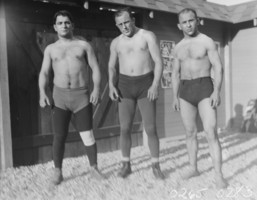
Film transparency of wrestlers posing, Las Vegas, May 23, 1929
Date
1929-05-23
Archival Collection
Description
A picture of (from left to right) Leo Papionis (Greek wrestler from Los Angeles), Ira Dern (world light heavyweight grappling champion), and George Batalis (Las Vegas wrestler), all preparing for the World Championship Wrestling Match at El Patio Open Air Theatre.
Image
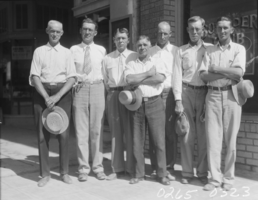
Film transparency of Las Vegas labor union officials, Las Vegas, 1930
Date
1930
Archival Collection
Description
Las Vegas labor union officials, in charge of Labor Day celebrations, in Las Vegas, Nevada. From left to right, the men pictured Martin Connell, James Farndale, William Gore, Robert H. Elser, Ira Liebert, Charles Watkins, and Eddie Bruner.
Image
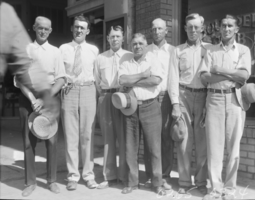
Film transparency of Las Vegas labor union officials, Las Vegas, 1930
Date
1930
Archival Collection
Description
Las Vegas labor union officials, in charge of Labor Day celebrations, in Las Vegas, Nevada. From left to right, the men pictured include Martin Connell, James Farndale, William Gore, Robert H. Elser, Ira Liebert, Charles Watkins, and Eddie Bruner.
Image
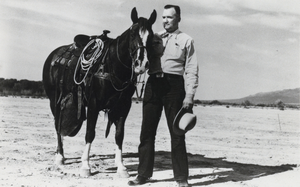
Photograph of George Malone posing beside Gimick the horse, Nevada, circa 1947-1959
Date
1947 to 1959
Archival Collection
Description
Senator George Malone standing next to Gimick the horse in the desert in Nevada. The postcard caption reads: "Senator Malone and "Gimick," one of the top roping and dogging horses west of the Rockies. Gimick has to stand on his tiptoes to be 14 " hands high-weighs 1,050 pounds and on the "getaway" the third jump he is going as fast as he is ever going to go. The Senator gets a calf about every second or third throw."
Image
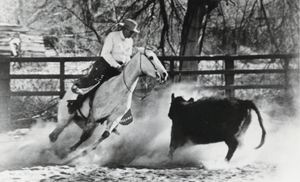
Photograph of George Malone riding his horse PAYDIRT, circa 1947-1959
Date
1947 to 1959
Archival Collection
Description
Senator George Malone riding his horse PAYDIRT in what could possibly be Nevada. The postcard caption reads, "Senator Malone up on his "Cutting horse PAYDIRT" - the little Quarter horse mare stands 14 " hands high and weighs 1,050 pounds. PAYDIRT- a top competitor in any company- is cream colored buckskin with blue stripe down her back."
Image
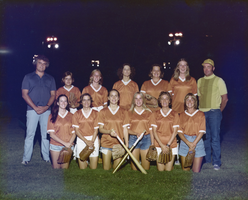
Photograph of Garrett Realty softball team, 1976
Date
1976
Archival Collection
Description
The Garrett Realty softball team posing in an unidentified field. Description included with image: "They took 2nd place. Front row, left to right: Ellie Harshman; Marti Corderman; Diane Moorhead; DeAnn Dunbar; Raini Dunbar; Kathy Dosch. Second row, L-R: Assit, Coach Paul Dosch; Becky Jones; Kathy Morang; Brenda Graupensperg; Norma Goudie; Leslie Adams; Coach Wendell Goudie. Not shown: Mary Lenon, Cathy Bateman, Karen Mead, Cheryl Pinckney, Diane Walters, Vi Goudie, Judy Goudie, Debbie Jefferson, and Maureen McCormick."
Image
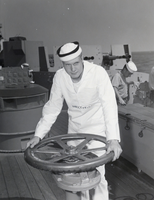
Photograph of William L. Sweet, circa 1951
Date
1951
Archival Collection
Description
Description provided with image: "Naval Reserves Officer Training Corps Midshipman third class William L. Sweet, University of Southern California, son of Mr. & Mrs. Charles L. Sweet of 519 New Mexico St., Boulder City, Nevada. Sweet operates the anchor windlass on board the USS Missouri during the current midshipmen cruise. The midshipmen are receiving instruction and "on-the-job" training in communications, navigation, gunnery, operations, and engineering during the four-week summer training cruise which will visit New York, Panama, and Guantanamo Bay, Cuba. There are 765 college students now aboard the MISSOURI studying to become future naval officers under the Holloway Plan. Upon returning to Norfolk, Virginia on September 3, the Midshipmen will depart for their homes to prepare for entering the forthcoming college term August 1951."
Image
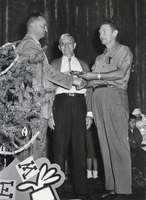
Photograph of a children's Christmas party, Boulder City, Nevada, December 23, 1960
Date
1960-12-23
Archival Collection
Description
A Children's Christmas Party held in the Boulder Theatre in Boulder City, Nevada. The caption reads, "Thank you, Don! President Bob Glinski of the Boulder City Chamber of Commerce tells Don Jones of appreciation of business men and the youngsters for the theatre manager's help in giving the kids a wonderful party Saturday afternoon. Santa is in the background with some of the youngsters and Bill French, member of the chamber's board of directors, helps host, watching presentation of a thank you present to Jones." Individual Creator credit goes to Dick Lewis.
Image
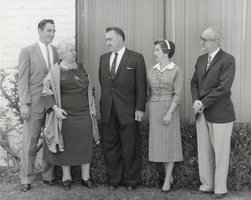
Film transparency of L-R: Floyd Lamb, Ida Browder, Mr. & Mrs. Walter Baring, and Elton Garrett, probably in Boulder City, Nevada, circa 1950s
Date
1950 to 1959
Archival Collection
Description
From left to right: Floyd Lamb, Ida Browder, Mr. & Mrs. Walter Baring, and Elton Garrett, probably in Boulder City, Nevada, circa 1950s.
Image
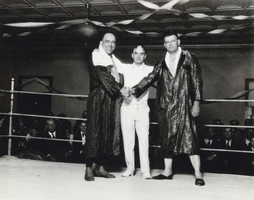
Film transparency of wrestler Lewis Montagna (left), S.F. Vaneman (right), and referee Sam Herman (center) in Las Vegas, Nevada, circa 1920s-1950s
Date
1920 to 1959
Archival Collection
Description
Lewis Montagna "Bull Montana" a professional wrestler (left), S.F. Vaneman (right), Sam Herman the referee (center) in Las Vegas, Nevada, circa 1920s-1950s.
Image
Pagination
Refine my results
Content Type
Creator or Contributor
Subject
Archival Collection
Digital Project
Resource Type
Year
Material Type
Place
Language
Records Classification
